

THE PERU - EQUATOR CONFLICT

Perú is a country that has always cherished peace, this is a concept that is part of the peruvian society, nevertheless, this peaceful nation has been harassed many times by the north neighbor, Equator.
Although there are some stories about the Peru-Equator conflict's origin, no one knows exactly how the Peru-Equator conflict was originated, however some guys lacking of any knowledges in history, geography, and treaty history have written the following: "The genesis of the conflict lies in the imprecise borders of Spanish viceroyalties and administrative districts during colonization, as well, as in changes of territory between these viceroyalties. Further, during the independence movements of the early 19th century efforts to delimit the boundary were frustrated by the fact that the disputed area was part of the larger entity of Greater Columbia, Peru and Equator at different times. Mistrust and nationalism too are at the root of the dispute. In 1941 Peru was able to overwhelm about 3,000 equatorian soldiers with a well-equipped force of 15,000. Indeed, "Equatorian school texts and historical writings assert that the original national territory has been reduced by nearly two-thirds" (Marcella, 1995) over time". All of this affirmation is very mistaken because the Peru-Equator conflict began in 1840 and not dates from the colonial times.
The Equator's absurd, inadmissible claims in the Peru's amazonian region and other Peru's lands (Peru's provinces of Tumbes, Jaén and Maynas) are the pretext why the conflict was begun by Equator in 1840. Tumbes, Jaén and Maynas have always been Peru's territories since the independence times (1821) besides according to Royal Cedule of 15 of July of 1802 and Uti Possidetis jure of 1810 Tumbes, Jaén and Maynas are Peru's territories.
The Royal Cedule of 15 of July of 1802 was drew up by King Charles IV of Spain, who was a King of absolute power, therefore all his orders were executed by his subordinates under the death penalty.
On September 22, 1829, the Larrea-Gual Treaty was signed in Guayaquil by Peru and the disappeared Greater Columbia, this treaty was not a limits treaty but a Treaty of Peace and Friendship. Equatorians say Larrea-Gual Treaty established the Marañon-Amazon River as the border between Peru and Equator, they are wrong because according to spirit of the 5th Article of the Larrea-Gual Treaty the border between Peru and the Greater Columbia (and not Equator) is established according to Royal Cedule of 15 of July of 1802 and Uti Possidetis jure of 1810.
In May of 1830 the Greater Columbia was disappeared as a country, when both Equator and Venezuela withdrew and became separate nations (Venezuela withdrew on May 6, 1830 and Equator withdrew on May 13, 1830), consequently, all agreements signed by Peru and the Greater Columbia were invalidated.
The supposed Pedemonte-Mosquera Protocol supposedly signed on August 11, 1830 (after the Greater Columbia was disappeared as a country in May of 1830) by Perú and the disappeared Greater Columbia in fact is a false treaty, Equator has never been able to demonstrate the existence of the make-believe Pedemonte-Mosquera protocol that too there is not some left in the archives of the foreign offices of Perú and Columbia even.
Equator was born as a country on May 13, 1830 -after the Republic of the Greater Columbia was dissolved in May of 1830- and began its separate existence with the adoption of a constitution on September 23, 1830, according to this constitution Equator was comprised of the provinces of Azuay, Guayas and Quito covering a surface area of 159,876 square kilometers of territory comprised of coast and sierra only, therefore Equator was never an amazonian country from its birth.
Equator was born angry due to its narrow territory and since 1840 it has always tried to expand its borders and to gain more territory attacking Peru.
The first treaty between Peru and Equator was to be signed on July 12, 1832, this agreement was the Pando-Noboa treaty. The 14th. Article of this treaty established: "While a settlement about limits arrangement between both of states is holding, the present limits must be recognized and respected".
The Pando-Noboa treaty confirms the inexistence of the false Pedemonte-Mosquera protocol and the caducity of the Larrea-Gual treaty. However Equator contested the Pando-Noboa treaty in 1840 because according to Pando-Noboa treaty Equator recognized the provinces of Tumbes, Jaén and Maynas as Peru's territories according to Royal Cedule of 15 of July of 1802 and Uti Possidetis jure of 1810.
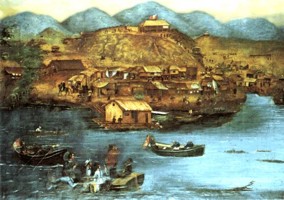
This Picture by anonymous painter depicts the taking of Guayaquil by Peru's Army in 1860 (1,48 x 0,80 m.). Room Castilla. Photo: National History Museum in Lima |
In 1857, Equator ceded wide spaces of Peru's amazonian region, in the zone of the peruvian rivers Pastaza and Bobonaza, in its english creditors' favour. Peru protests because of Equator attitude but Equator held its wrong attitude and forces Peru to settle the matter by force. After a Peru's Army victorious campaign lasting about two years, an armistice was arranged. On January 25, 1860 Peru and Equator signed the Mapasingue treaty. According to this treaty the lands ceded by Equator in its english creditors' favour were recognized as Peru's territory according to Royal Cedule of 15 of July of 1802 and Uti Possidetis jure of 1810.
Both Equator and Peru declared the Mapasingue Treaty to be null, Equator in 1861 and Peru in 1863.
In 1936 was signed by Perú and Equator the Act of Lima establishing the Statu Quo of the positions that then both countries had in the border, that same year representatives from Peru and Equator were reunited in Washington, D.C. in order to negotiate a treaty, but the conversations failed because of the equatorian intention to reach to peruvian rivers Marañon and Amazon.
Later in the years between 1938 and 1940 Equator begins a series of offensives that worsen when Equator installed positions in Peruvian zone, violating the Statu Quo of 1936, originating the 1941 war. In 1941 Equator was decided to settle the matter by force and It didn't has any scruple to cause a border clash in July 5, 1941 in attacking the peruvian peasants, who had their tobacco plantations in Peru's territory near to the border, and the peruvian border posts of Aguas Verdes, Las Palmas and Lechugal.
Equator was guilty of the 1941 war because It sought of great territories of Peru, i.e. the provinces of Tumbes, Jaén and Maynas, which have always been Peru's territories since the independence times (1821).
From the 1941 War to the Protocol of Rio de Janeiro
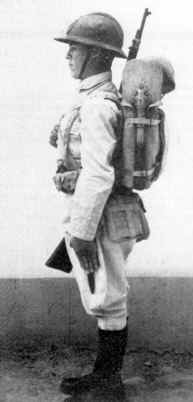
Peruvian Infantry Soldier in military uniform from the times of the 1941 war, he wears on his head a french helmet "Adrian Model 34" |
The modern period of conflicts between Peru and Ecuador dates from 1941 when a series of skirmishes caused by Equator along the border developed into a full-scale war.
All these skirmishes were begun before 1940 when equatorian troops take by storm the Peru's Matapalo Island and other peruvian territories over 13,480 Km2.
The beginning of the fighting happened on July 5, 1941 when Equator Army's soldiers entered in Peru's territory in order to remove the wire-work of a peruvian farm. In the same day equatorian troops attacked the peruvian border posts of Aguas Verdes, Las Palmas and Lechugal.
In order to repel the cowardly equatorian attack the peruvian goverment ordered the creation of an Army Corps named the Group of the North under the command of General of Brigade of Peru Army Eloy Gaspar Ureta Montehermoso, who with the help of 11,681 brave, well trained soldiers of Peru Army (from the Grouping of the North and Division of Jungle) attacked invading Equatorian troops, the equatorian soldiers were not prepared for war, with a modest defense force (roughly 5,300 men from the 5th. Brigade of the Equator Army (this Brigade was compresed of troops for border watching and troops were to Arenillas, 19 km. from the front), about 1/2 the size of the Peruvian army). In spite of Equator bought modern rifles in large numbers, 30 anti-aircraft machine-guns and several Curtiss-Wright CW-19R battle airplanes, that the equatorian pilots were unable to manage with complete knowledge (the most of all this modern armament was taken by Peru's armed forces and borne to Lima) its troops did not have
the equipment nor the training to defend their illegal positions in Peru territory.
There were very heroic demonstrations of courage in combat from the defensive forces of Peruvian nation. For example: The Peru Air Corps saw action again, this time with another Northern neighbour: Equator. During that conflict Captain CAP José Abelardo Quiñones González was killed in his North American NA-50 fighter aircraft "Little Bull" (named Panther) during an air raid on Quebrada Seca in Equator. Quiñones directs its fired aircraft against the antiaircraft battery position and he destroys it completely. For this heroic action he is patron of the Peru Air Force ever since.
|
THE AIRCRAFTS OF THE PERU AIR CORPS IN 1941 WAR

North American NA.50 "Little Bull" of the 41th. Fighter Squadron

Caproni 310 "Libeccio" of the 11th. Squadron of Bombers.
|
Peru did not have many problems to defeat this invading country and has obtained a quick victory, the Group of the North (441 Officers and 9,386 men) was supported by a Detachment of tanks, together with field-artillery and air support from the Detachment of Military Aviation.
Peru held Ecuador's southernmost province of El Oro and the Division of Jungle of the Perú Army (1,845 men) under the command of the of General of Brigade of Peru Army Antonio Silva Santisteban, recovered in Peru's favour much of the North-Eastern jungle territory took by Equator in 1882 and that had been part of Perú since 1810.
The Peruvian military occupation of the province of El Oro was an act of reprisal recognized in the international right, that did not have reason of conquest or dismemberment of equatorian territory. Perú withdrew its troops after the subscription of the Protocol of Peace, Friendship and Limits of Rio de Janeiro, that ended the conflict. Peru did not demand indemnification military payment.
After this unmatched war, Peru decided to print their just, right victory and a fire cease was brokered by Argentina, Brazil, Chile and the United States. After complicated negotiations Peru and Equator reached an agreement about the frontier line, and signed the Protocol of Peace, Friendship, and Boundaries of Rio de Janeiro, on January 29, 1942.
The equatorians say that Peru in 1942 has obtained 200,000 Km2 more than in 1829 (?), Peru in 1942 has obtained 70,000 Km2 more than in the treaty of 1890 (?), Peru has obtained in Rio de Janeiro 56,000 Km2 more than it was assigned by the Spanish decree of 1910 (?), all of them affirmations are false, the Protocol of Peace, Friendship, and Boundaries of Rio de Janeiro of 29 of January of 1942 never awarded to Peru some 200,000 square kilometers of previously disputed Amazon territory, on the contrary, the Protocol of Peace, Friendship, and Boundaries of Rio de Janeiro awarded to Equator some 110,974 square kilometers of peruvian Amazon territory took by Equator in 1882 while Perú faced the cowardly attack of Chile. The Protocol of Peace, Friendship, and Boundaries of Rio de Janeiro never imposed on Ecuador acceptance of Peru's claims in the Amazonian region in return for Peruvian withdrawal from Ecuador's coastal provinces because the Protocol of Rio counted with the guarantee of the four responsible countries of the same one (Argentina, Chile, Brazil and United States of America).
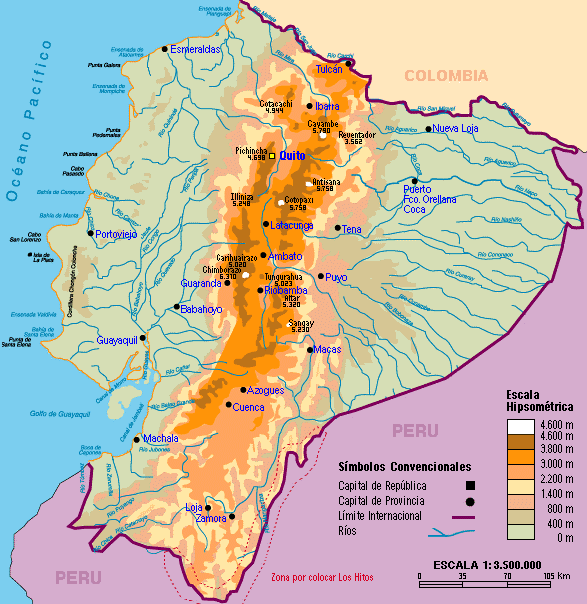
Map of Peru-Equator border according to the Protocol of Peace, Friendship, and Boundaries of Rio de Janeiro signed in 1942 |
The Protocol of Peace, Friendship, and Boundaries of Rio de Janeiro, signed in 1942, was in Equator's favour, this was recognized by the Equatorian Diplomat Julio Tobar Donoso, Minister of the foreign Affairs of Equator, in that time, who claimed: "Equator was given more than 5000 Km2 in certain zones (Sucumbios)".
Following the peace treaty of Rio ("Protocol of Rio"), and in cooperation with Argentina, Brazil, Chile, and the United States, Peru and Equator began demarcating the mutual border - a very difficult task in that time because most of it run through jungle and was far away from Ecuador's and Peru's major settlements. The USAF helped a lot by conducting a major air survey operation to map the whole frontier zone (before that there were maps of the required accuracy only for some parts of the border areas).
The Protocol had established the frontier line along the divortium aquarium of the rivers Santiago and Zamora, which was thought to be the Cordillera del Condor. It's said that USAF aerial survey discovered a new river, the Cenepa which ran form that mountain range to the Marañón river in a north to south direction, this is false because according to Peruvian Foreign Office the Cenepa river was discovered long before of the subscription of the Protocol of Peace, Friendship, and Boundaries of Rio de Janeiro in 1942. Cenepa River was known at least since the 19th. Century, suffice it to say that in 1869 peruvian seaman Melitón Carvajal was to sail down the Cenepa River in steam ship "Napo". Due to a series of offensives begun by Equator in 1938 peruvian president Marshal Oscar R. Benavides Larrea decided deploying reinforcements along the border and ordered the peruvian troops to march on Cenepa River, Benavides also ordered that one Garrison must be established into the Cenepa River Zone, this Garrison was to be named "Chávez Valdivia".
About the execution of the Protocol of Peace, Friendship, and Boundaries of Rio de Janeiro, signed in 1942, there were technical discrepancies in the eastern sector of the Peru-Equator border. This situation was submitted to a Brazilian mediator, Braz Dias de Aguiar who on July 14, 1945 established the Cenepa river to be in Peruvian territory and the line of frontier to run along the Cordillera del Condor, Equator accepted the decision of Dias de Aguiar with goodwill in that time.
Until November 11, 1950 Peru and Equator placed landmarks on the border.
But in 1951, Equator put a stop to the demarcation effort claiming puerilely the Protocolo had been signed before Peruvian troops withdrew from Equator, which was true but anyway ratification by the Equatorian parliament was done well after the Peruvian withdrawal. Also Ecuador complained about the Protocolo de Rio saying that this had been inapplicable in some sectors of the frontier, notably along the Cordillera del Condor in spite of the discrepancies ended with the decision of the Brazilian mediator, Braz Dias de Aguiar in 1945.
Equator did not accept the decision of Dias de Aguiar and declared the Protocolo to be inapplicable.
Thus, in the following years, the demarcation effort remained stopped due to Ecuador's refusal to accept the Protocol of Rio signed by it in 1942 even if most of the frontier had already been demarcated according to it (out of some 1,660 km of the mutual border only some 78 km in the area known as Cordillera del Cóndor remained unmarked).
Equator was guilty of the stopping of the demarcation effort.
Along the zone supposedly in dispute both countries established several military outposts, Ecuador on the heights of the Cordillera del Condor and Peru on the Cenepa Valley.
The Upper Comaina War
In order to achieve the conquest of the Amazonas River, National Objective of Equator, the Equatorians were closely following the defensive developments in Peru and developed a corresponding capability. Consequently, especially in the early 1980 decade Equator started purchasing new fighter-jets, starting with Dassault Mirage F.1AJ aircrafts, in 1983, via IAI Kfir C.2 aircrafts (in same year), through Cessna A-37B aircrafts and BAE Strikemaster aircrafts (between 1980 and 1987) thru BAE Jaguar aircrafts.
Most of the aircraft operated by the Fueza Aérea Ecuatoriana (FAE) were based in Quito: even the new pilots and other personnel for FAE is trained there.
On January 22, 1981 a Mi-8T Hip transport helicopter from the Peru Army Aviation discovered an Equatorian infiltration -in peruvian territory- south of the Cordillera del Condor, (Eastern Sector) where the Equatorian military established a new outpost, named Paquisha (the same name of another Equatorian outpost north of the Cordillera del Condor -usually shortened to Condor Cordillera), the peruvian helicopter was attacked by equatorians soldiers and in order to evade the enemy bullets the peruvian pilot made evasive maneuvers successfully. The Peruvian government denounced the infiltration as aggression and claimed Paquisha to be an illegal outpost according to the Protocol of Rio de Janeiro, giving it the name Falso Paquisha (False Paquisha) to distinguish it from the other outpost in well established equatorian territory. The Peruvian Army organized an attack to expel Equatorian troops from their positions in peruvian territory, Hostilities occurred, again in Peru's favor.
Given the nature of the conflict, the Peru Air Force was utilizing its assets very carefully. Initially, only the A-37B aircrafts of the 7th. Air Group, based in Piura, were used for flying few strike sorties. But, with the time they were joined by Mirage 5P aircrafts of the 6th. Air Group, based at Chiclayo, which performed as escorts. The majority of the Sukhoi Su-22 Fitter aircrafts of the 11th. Air Group (the tigers house) were held back in the coastal region, in reserve and as a dissuasive force. Nevertheless, they flew some strike sorties as well, and in total the Peruvians recorded that the 111th. Squadron flew no less but 79 hours in combat during this war, including some air defence and reconnaissance missions.
In order to expel the equatorian enemy from Peru territory the Peru Armed Forces mounted a heliborne operation, it was the first heliborne operation in the history of South America, using Mi-8T Hip transport attack helicopters from the Peru Army Aviation and the 3rd. Air Group of the Fuerza Aérea del Perú (Peru Air Force, FAP). The operation was a success and Falso Paquisha was taken by Peruvian troops with little casualties. The Peruvian president Fernando Belaunde visited the site a few days later and exhibited to the press some of the captured equipment, including several quadruple antiaircraft machine guns, as mounted during World War II on some M-16 half-tracks. As they stood alone on the battlefield in the end - Peruvians were the winners because they achieve to expel to invading troops.
| Historical Photo: The Peruvian President Fernando Belaunde Terry shows the quadruple antiaircraft machine guns that the invading forces of Equator placed in the eastern sector of the Cordillera del Cóndor in 1981, i.e. in peruvian territory in the conflict of the "False Paquisha" near to peruvian Comaina river. Equator named as "Paquisha" to its position infiltrated in peruvian territory in order to lie to the world. In fact this position is the Peruvian Watch Outpost Nº 22 (PV- 22 better known as "Falso Paquisha" ever since).
"Paquisha" is an Equatorian outpost placed in the north sector of the Cordillera del Condor. |
False Paquisha and the other points that the enemy infiltrated in peruvian territory in 1981 were military outposts consisting of a clearing in the jungle barely large enough to permit helicopter landings and some kind of quarters for a small garrison. There are no villages in the region: except for few Indian tribes living in small groups, this area is very scarcely populated.
Thus, the 1981 conflict remained localized along a very small front, despite the General in Chief of Peru Army, General of Division of Peru Army Rafael Hoyos Rubio suggested the President Belaunde to cross the border and to initiate a full scale conflict and the occupation of an Equatorian province to guarantee the full execution of the 1942 Protocol of Rio, Belaunde did not accept it.
After this clash, Equator and Peru established a chain of bases in the jungle of the Condor Cordillera area, along a 76 km long corridor between Zamora and Santiago Rivers. A chain of very high raised observation posts supported these bases. Some of these posts and bases were very close near each other, and many skirmishes -caused by equatorian troops- erupted time and again.
Due to a complete lack of any roads, the only way of supplying and supporting these bases and posts was from the air, usually with the help of helicopters, although, with the time also a number of small strips were built in the jungle.
The Upper Cenepa War
In the mid-1990 decade Peru used much of its military forces in order to suppress the Shining Path guerilla movement. Ecuador pretended to take advantage of the opportunity by establishing and garrisoning outposts along defensible terrain in the Peru's territory protected by artillery and thousands of minefields. The infiltration of the equatorian troops in peruvian territory began in 1994.
On December 12, 1994, the officer in charge of the Peruvian 25 Battalion "Callao", ordered his counterpart of the Ecuadorian 63 Battalion "Gualaquiza" to evacuate the zone of Peru's territory where equatorian soldiers were infiltrated, these two units were opposing each other, because the equatorian forces were about to occupy the Peruvian territory during the approaching weekend, because of it the two units almost immediately engaged in a battle that was to last for the following two days. The peruvian demands were not rejected and an agreement was to be reached, equatorian troops withdrew from the false Cueva de los Tayos in the same day, equatorians were neither in the Christmas nor in the New Year but at the beginning of January of 1995 they returned back to false Cueva de los Tayos with more men.
In early 1995, both armies started to concentrate troops in the Cenepa Valley. On the late afternoon of 9 January, around 17:30hrs, four men of a Peruvian Army patrol (Patrol "Rommel" of the 25th Battalion of Jungle Infantry "Callao" of the 5th Division of Jungle Infantry) who were hunting and walking on the left bank of Peru's Cenepa River in a reconnaissance mission in order to see the preservation of the border line detected roughly 20 equatorians soldiers in Peruvian territory. This little incident was surpassed and Peruvians and equatorians went to the equatorian military base "false Cueva de los Tayos", on 11 January, in the point known as the "Y" of the invading troops, i.e. in Peru's territory, a party of equatorian soldiers came up against another Peruvian patrol (Patrol "Storm" of the 25th Battalion of Jungle Infantry "Callao" of the 5th Division of Jungle Infantry) who were in a reconnaissance mission and walking on Peru's territory in order to search for landmark named "November 20", the peruvian troops opened fire in order to defend their own lives from the cowardly enemy attack and a pitched battle was fought, two invading equatorians were killed and several of them were disappeared, peruvians didn't have any casualty.
After incidents of 9 and 11 of January of 1995 a meeting between Colonel of Equator Army Jose Grijalva Palacios (CO 21st. Brigade of Jungle "Condor" of Equator Army), and Lieutenant Colonel of Peru Army Manuel Lazarte Alatrista (CO of the 25th. Battalion of Jungle Infantry "Callao" of the 5th. Division of Jungle Infantry of Peru Army) was to be done on January 13, 1995, and as a result of it, the equatorians soldiers did not accept to leave the peruvian territory invaded by them.
The Peruvians then started deploying reinforcements along into the crisis area, mainly with the help of helicopters, and on 19 and 22 January equatorians started a attack on peruvian heliport "Storm" situated in the neighborhoods of the Cenepa River basin. All of their attacks were repelled.
The equatorian military and goverment were employed to provoke the war, but it was essential that "Peru begin it": Then the equatorian military and goverment could announce, the war exists by acts of Peru.
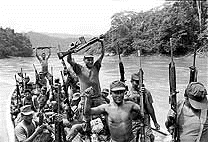
Peruvian Infantry Soldiers in military war uniform on the peruvian jungle rivers prepared to expel the enemy |
Fighting broke out in January 26, 1995, the Equator Army attacked cowardly a peruvian patrol in Quebrada Fashin (peruvian territory according to Protocol of Peace, Friendship, and Boundaries of Rio de Janeiro, signed in 1942) and at its height, about 3000 Ecuadorian and 9500 Peruvian troops were deployed in the region. Additionally, Ecuador "marshaled tanks and artillery along the western coastal border, where no fighting took place" near another supposed contentious area involving a canal. The hostilities were, once again, decidedly in favor of Peru's Armed Forces in spite of that Equator had the advantages of terrain, shorter lines of communication, and new technologies. Six Peruvian aircraft were shot down by the enemy on the Cenepa Valley -i.e. because of battle field nature (Cenepa Valley is a true alley)- two peruvian aircrafts were lost because of mechanical failure and casualties were higher for Equator (its army had more than 200 killed soldiers while Peru Armed Forces had 60 killed
soldiers), in spite of those all problems Peru achieves to expel the enemy from its garrisons infiltrated in peruvian territory named as false Cueva de los tayos, false Base Sur and false Tiwintsa. Equator Army attacked the peruvian soldiers in order to invade and to take again Peru's territory and peruvian troops opened fire. All of Equator attacks actions were successfully repealed.

Peru Air Force: Cessna A-37B Dragonfly light bomber-fighter aircraft of the 7th. Air Group |

Peru Air Force: BAC Canberra B (I) Mk.12 bomber aircraft of the 9th. Air Group |

Peru Air Force: EMB-312 TUCANO AT-27 training aircraft of the 51th. Air Group |

Peru Air Force: AERMACCHI MB-329 training aircraft of the 51th. Air Group |
When hostilites started the Peru Air Force launched a crash programme to bring as many aircraft into operational condition as possible. Even EMB-312 Tucano training aircraft were commited to the fight: equipped with NVG, they were employed on night attacks with iron bombs against equatorian positions.
At dawn of the 5 of February of 1995, six Peru Air Force's Tucano EMB-312 AT-27 war airplanes loaded with a dotation of four iron bombs of 500 pounds each one took off from a unknown base with the mission to bomb an equatorian objective infiltrated in Peruvian territory very next to recovered the false South Base. The crew sailed on 200 feet of height on trees using instrumental of the navigation and the infra-red device glasses, the mission was successful.
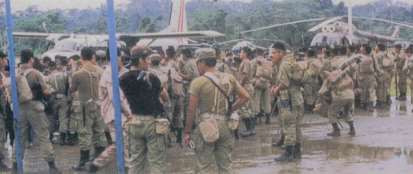 |
 Troops of the Peru Army at "Ciro Alegría" Base prepared to go to the battle field in order to expel the enemy. Troops of the Peru Army at "Ciro Alegría" Base prepared to go to the battle field in order to expel the enemy.
In the background a Harbin Y-12 transport aircraft and a Mil Mi-8T Hip transport attack helicopter of the Peru Army Aviation Corps. |
Helicopters types of the Peru Air Force and the Peruvian Army Aviation employed during the fighting were Mi-8T Hip and Mi-17 from the 811th. Assault and Transport Battalion and 821th. Assault and Transport Battalion respectively (both from the Peruvian Army Aviation). Peru Air Force employed Mi-8, Mi-17 and Bell 212 Helicopters from Grupo Aéreo (Air Group) No. 3 and Mil Mi-25 Hind D Helicopters from Air Group No. 2. They were used intensively in the Cenepa because lack of roads made them the only way to bring supplies to the forward line quickly. They also provided fire support with rocket and gun pods, but Ecuador "had learned" the leason from 1981 and deployed quite large numbers of MANPAD missils and AAA coupled to an adequate radar network. For that reason there were losses.
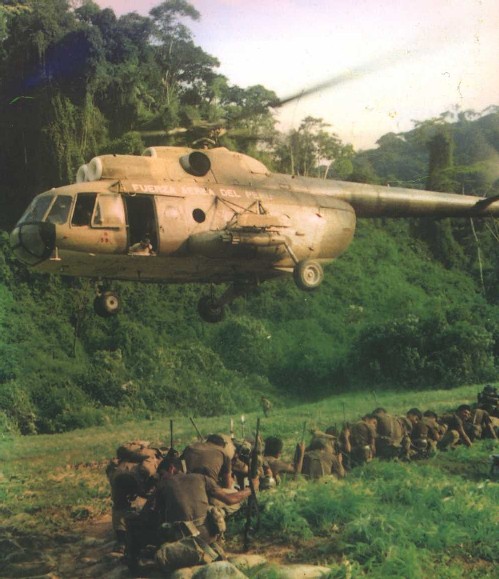 |
 Assault Transport Helicopter Mi-8T Hip of the Peru Air Force getting up after of landing troops of Jungle Infantry of Peru Army in the battle field during the Upper Cenepa Conflict. Assault Transport Helicopter Mi-8T Hip of the Peru Air Force getting up after of landing troops of Jungle Infantry of Peru Army in the battle field during the Upper Cenepa Conflict.
What a glorious epoch! the Peru Armed Forces's assault transport helicopters landed many brave peruvian soldiers while attacking enemy positions launching it rockets, missilles and grape-shot from their gun pods without no limitation causing it many killed soldiers. |
Some details are known about the Peruvian aircraft lost during this period. These included a Mi-8T (EP-587), shot down by a Blowpipe MANPAD missil 4 Km. North Eastern from the false base Cueva de los Tayos -in peruvian territory-, on 29 January (the crew, including Captain EP Luis Garcia Rojas, Lieutenant EP Augusto Guitérrez Mendoza, 3rd. Technician EP Victoriano Castillo Velarde, 1st. Under-Officer EP Rubén de la Cruz Huarcaya, and 3rd. Under-Officer EP Gustavo Begazo González, was killed); BAC Canberra B (I) Mk.8, which probably crashed against a mountain in bad weather conditions (in fact the old aircraft was lost due to a mechanical failure), on 6 February, 1995 (the crew, Captain FAP Percy Phillips Cuba, and Captain FAP Miguel Alegre were reported as dissapeareds); and a Mi-25 Hind D assault helicopter, shot down by two or three SA-16 missils while attacking successfully equatorian illegal positions over the false Base Sur, on 7 February, around 14.30h. (the crew, Commandant FAP Marco Schenone Oliva, Captain FAP Raúl Vera Collahuazo, and Under-Officer FAP Erick Diaz Cabrel, were all killed) the peruvian Mi-25 Hind D helicopter achieved to shoot all its rockets causing great damage in the enemy before of falling into the jungle, the equatorians hit also a Peru Air Force Bell 212 on January 28, 1995, this aircraft was hit by the enemy bullets in its oil tank causing a wounded crewman.

Peru Air Force: Mil Mi-17 Hip assault transport helicopter of the 3rd. Air Group |

Peru Air Force: Mil Mi-25 Hind D assault helicopter of the 2nd. Air Group |
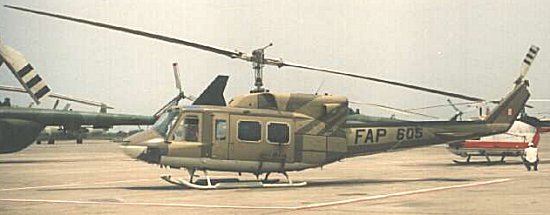
Peru Air Force: Twin Bell 212 assault transport helicopter of the 3rd. Air Group |
On February 7, 1995, Equator Air Force (FAE) established a CAP (combat air patrol) over the Cenepa Valley and sends several waves of A-37B aircrafts into strikes -all escorted by Mirage and Kfir aircrafts, and the first FAE aircraft to get hit by Peruvian air defences was damaged already on that day. The aircraft was an A-37B and flown by Lt. Col. FAE Briones: he was in attack against the Peruvian post on the Condor Mountain, when his wingman warned him of a missile. Seconds later a MANPAD missil detonated near the right engine, causing much damage. Nevertheless the damage caused was not heavy, and the aircraft was operational again later on the same day.
After a failure of negotiations, on 9 February 1995, fiercest fighting so far broke out and the Peru Air Force was now very active over the Cenepa battle field (where had a whole chain of hot spots, where small units were clashing with each other).

Peru Air Force: Mirage 5/P air supremacy interceptor bomber-fighter jet of the 411th. Fighter Squadron of the 4th. Air Group |
On that day alone, the Peru Air Force flew 16 sorties, some of these by Mirage 5P and Su-22 fighter-jets, foremost against Equatorian posts around Coangos and the False Base Sur. In the following night, additional strikes were flown by BAC Canberra B (I) Mk.8 bombers against Equatorian positions infiltrated in the Peru Cenepa valley, and in the morning of 10 February A-37B and Su-22 aircrafts flew a series of attacks against false Tiwintsa and around false Cueva de Los Tayos.

Peru Air Force: Sukhoi Su-22A Fitter F interdictor bomber-fighter Jet. Can be seen the combat shield of the 111th. Bombing-Fighter Squadron "The Tigers" applied in front of the left side of the cockpit
|
On February 10, 1995, about 13.00h., two Equatorian Kfir C.2 aircrafts detected two Peru Air Force A-37B aircrafts. Captain FAE Mata, flying Kfir FAE-905, managed to position behind the A-37B aircraft flown by Commandant FAP Hilario Valladares (pilot) and Mayor Gregorio Mendiola (crew) and shot two missilles Shafrir-IV AAM. Valladares achieves to evade the first enemy missil but he could not evade the second missil in spite of his evasive maneuvers, the enemy missil with difficult hit the aircraft and this was damaged, Mendiola ejected and Valladares tried to save his war airplane and to reach Piura, the aircraft started to lose height and Valladares ejected, Valladares y Mendiola were a day after recovered. The second Kfir C.2 aircraft managed to position behind the A-37B aircraft flown by Commandant FAP Fernando Hoyos (pilot) and fired its guns and missilles Shafrir-IV AAM. Hoyos achieves to evade the enemy fire and missilles, he managed to evade the Kfir by hard maneuvering at low level and returned safely to the base. Before of being attacked by the enemy Kfir aircrafts the two Peruvian A-37B aircrafts achieved to launch their iron bombs over the equatorian positions in false Tiwintsa.
The same day (February 10, 1995), by 13:20h., two Squadrons of Sukhoi Su-22A Fitter-F Fighter-Jets of the 11th. Air Group launched their iron bombs over False Tiwintsa hills causing many killed equatorian soldiers in their illegal positions in Peru territory. During the battle two Sukhoi Su-22A Fitter-F were downed by anti-aircraft artillery of the Equator Army and two Peruvian pilots ejected from their fired aircrafts, but died several days later, their bodies and the wreck of one of the two Su-22 plane were found several days later.

Peru Air Force: Sukhoi Su-22A Fitter-F bomber-fighter jet of the 111th. Bombing-Fighter Squadron of the 11th. Air Group (The Tigers House). In order to repel the enemy attack Peru not only trusts in its military power but trusts in the justice and rights |
Commandant FAP Víctor Manuel Maldonado Begazo "Rayo" and Major FAP Enrique Caballero Orrego "Poeta", Chasseur-Pilots of the 111th. Bombing-Fighter Squadron ("The Tigers") were the heroes of the Peru Air Force who were killed on February 10, 1995.
Commandant FAP Víctor Manuel Maldonado Begazo died from injuries suffered while falling through the jungle canopy (he was so badly injured, he couldn't even make use of his SABRE-radio, and subsequently bleed to death). On February 22, 1995, the wreckage of his aircraft was found deep in the jungle and on February 26, 1995, the body of him was found deep in the jungle.
Major FAP Enrique Caballero Orrego died also. On March 2, 1995 his body was recognized by his brother near to site named Santa María de Nieva.
After heroic action of the peruvian pilots, two Equator Air Force's Mirage F-1 aircrafts managed by pilots Banderas and Uzcátegui fly to the border, the equatorian pilots feel an electronic danger from Peru Air Force's Mirage 2000/P (armed with R.550 Magic Mk.2 air-to-air missilles and iron bombs) and Sukhoi Su-22 Fighter-Jets and decide to take to flight cowardly, This action is recognized by equatorian pilot Banderas. The cowardly equatorian pilots permitted the peruvian fighter-jets to do their work without no problems and consequently many equatorian soldiers infiltrated in peruvian territory were killed in False Tiwintsa hills due to the very hard bombardments of the invincible Peruvian Air Force.
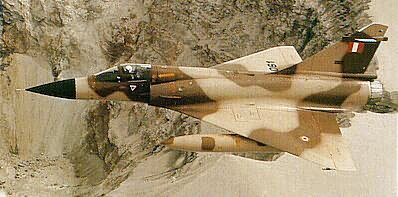 |
 THE POWERFUL PERU AIR FORCE'S STEEL EAGLES THE POWERFUL PERU AIR FORCE'S STEEL EAGLES
Peru Air Force: Mirage 2000/P air supremacy interceptor bomber-fighter jet of the 412th. Fighter Squadron of the 4th. Air Group.
On February 10, 1995 two Equator Air Force Mirages F-1 aircrafts have got warnings on their RWR Radars that they were tracked by Peruvian Mirage 2000/P fighter-jets, the two equatorian pilots fell in fear and thus they distanced away. |
In this manner the Peru Air Force's Fighters-Jets -without firing any missile or bullet- achieved to establish an air supremacy over the battle field in Upper Cenepa Sky and adorned their wings with glory, triumph laurels, peruvian fighter-pilots were the Lords of the Cenepa sky, the Peru Air Force was the Upper Cenepa Sky King.
If you want to see an interesting animation about air combat over Cenepa Hills please to press mouse here
Equatorians say Equator Air Force's two Mirage F-1 aircrafts shot down two Sukhoi Su-22 aircrafts of the Peru Air Force, this is false because according to Official Press Notice from the Equator Armed Forces General Staff, dated February 11, 1995, the two Sukhoi Su-22 were downed by anti-aircraft artillery of the Equator Army (this Official Press Notice was published in two equatorian newspapers and can read it under these lines).
|
Official Press Notice from the Equator Armed Forces General Staff dated February 11, 1995
.....the air defense of the Equatorian army downed yesterday, by 14h30, a supersonic airplane SUKOI and an airplane of fire support A-37 of the Peruvian Air Force, that intensified the bombardments in the zone of territorial conflict. A third airplane SUKOI was hit, but it was not gotten to know his final destiny.
THREE AIRPLANES Equal in way the General Staff in time of the night informed that two Peruvian airplanes military were downed and another one of A-37 support was damaged by Equatorian anti-aircraft fire during happened combats Friday around 14H00.
From : Daily "HOY" from Quito - Equator dated February 11, 1995. |
|
Official Press Notice from the Equator Armed Forces General Staff dated February 11, 1995
.....the air defense of our army (equatorian army), located in the area, downed Friday, by 14h30 a supersonic airplane Sukoi, an airplane of fire support A-37 and a third Sukoi airplane was hit without knowing its result.
From : Daily "EL UNIVERSO" of Santiago de Guayaquil - Equator, Year 74 Nº 149 dated Saturday 11 of February of 1995. |
Equatorians changed the first version deliberately in order to find military tradition for their little air force and because it is more impressive to say that two aircrafts were managed to down in dog fight, equatorian falsified the history, they are reverend falsifiers. But there are some impressionable guys in the cyberspace who believe in this great equatorian invention (for example: Tom Cooper from the ACIG, whose unfortunate, wrong essay published in the ACIG web site repeats the equatorian view point only), these poor devils are as blind as a bat, they seem to be no scholars.
In fact one Peru Air Force's Sukhoi Su-22 aircraft was downed by anti-aircraft artillery, when done an attack in low height, the second Peru Air Force's Sukhoi Su-22 was lost because of a fire in its turbine (mechanical failure) according to Peru Air Force official information.
Despite the losses, the Peru Air Force continued flying strikes on the following morning as well, while its helicopters continued supporting ground troops, deploying additional commandos on strategically important peakes. Mi-8T Hip showed as especially effective at given heights and under given climatic circumstances in spite of some problems were encountered with them.
On February 10, 1995, in the Zone of the false Tiwintsa base, the Peru Air Force gained a decisive victory on the enemy -in spite of the cost that it had when 3 peruvian aircrafts were lost (in all warlike confrontation some does not exist the victory without cost)-, that would be the prelude of the inescapable fall of the false Tiwintsa base, Peru Air Force's war aircrafts achieved the destruction of the equatorian anti-aircraft defenses inflicting in addition very hard damage to the enemy, this peruvian victory was recognized by General of Division of the Equator Army Paco Rosendo MONCAYO GALLEGOS in their "War Notes", that, on February 10, 1995, gives account of new bombardments by part of the Peru Air Force in Tiwintza (Zone of the false Tiwintsa base) and Banderas and adds the pressure that the Peruvian troops exerted on the equatorian troops, General MONCAYO says "....the bombardments (of the Peru Air Force) began to cause damage".
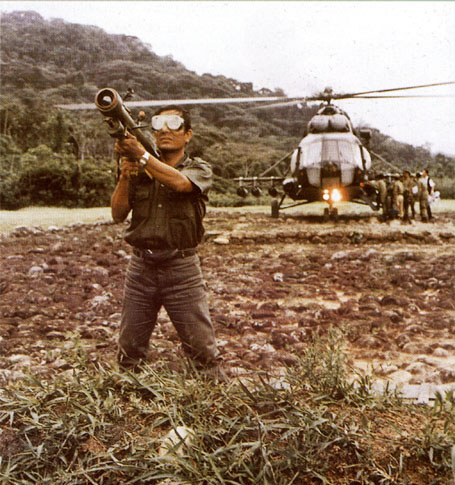 |
 THE PERU AIR FORCE'S ANTI-AIRCRAFT DEFENSE IN ACTION THE PERU AIR FORCE'S ANTI-AIRCRAFT DEFENSE IN ACTION
A sharp-shooter of the Peru Air Force anti-aircraft defense, he is armed with a supersonic, radaric "STRELLA" missile, he is watching the Cenepa Sky and is prepared to shoot down the enemy aircrafts.
The Shooters Group of the "STRELLA" Rocket Complex of the Peru Air Force Anti-Aircraft Defense played an important role in the invading enemy defeat, they changed the conflict development in Peru's favour. Due to them on February 11 and 12, 1995 three enemy aircrafts were managed to down over False Tiwintsa hills, consecutively the Equator Air Force suffered a humbling, big defeat and was reduced until its air space.
In this manner the path into false Tiwintsa was free, the conquest of False Tiwintsa was only a matter of time.
In the background a Mil Mi-17 Hip transport attack helicopter of the Peru Air Force. |
On Saturday February 11, 1995, by 11.00h., Peru Air Force war aircrafts launched grape-shot to the equatorian outposts "Banderas" and "Numbatkaime" (false Banderas), that with their fires they supported the invader.
Peru Air Force's pilots, antiaircraft defense and special forces in knowing the heroic action of the brave peruvian pilots fell in courage very much in order to destroy and to expel the enemy from the peruvian territory.
In fact, some days later Peru Air Force's antiaircraft defense and special forces in a combined action between both of them opened the path that leaded the brave peruvian troops to false Tiwintsa which was to be taken by Peru Army's Infantry on February 14, 1995.
As a result of it, on 11 and 12 of February of 1995, Peru Air Force's antiaircraft defense achieved to manage to down 3 Equator Air Force's aircrafts over false Tiwintsa hills.
In fact, on February 11, 1995 Equator Air Force's A-37B aircrafts belonging to the 2311 Squadron started from their base in order to attack the peruvian troops on the Cóndor mountain range. Between 17:30h and 18:30h peruvians detected two Equator Air Force's A-37B aircrafts (apparently one incomplete bombing squadron) flying from the equatorian base of Coangos to the "Y" in order to attack the zone. Peruvian Under-Officer: Technician FAP Sanjinés Roldán fired one "Strella" missile, the equatorian aircraft's crewmen tried to evade diving but the peruvian missile hit the A-37B aircraft FAE-293 which was hit in front of the left intake and badly damaged -it returned dramatically to the base and was subsequently repaired. In fact, this aircraft was underway as Number 2 in another formation led by Lieutenant Colonel FAE Briones. Its crew, consisting of pilots M. Camacho and R. Rojas, managed to regain control and -despite considering the possibility of an ejection - eventually returned back to
base, escorted by Briones. Every since, this Dragonfly carries a small title "Tiwintza" in black on the left side of the fuselage, underneath the canopy.
|
This photo shows the damage caused by a peruvian "STRELLA" missile to an equatorian A-37B subsonic war airplane, on February 11, 1995 in false Tiwintsa.
Technician FAP SANJINEZ ROLDAN from the Shooters Group of the Anti-Aircrafts Defense of the Peru Air Force fired one "STRELLA" missile, his missile hit the enemy aircraft.
|
 |
Peruvian fighters seen the equatorian airplane when it was hit by peruvian missile but the equatorian monkeys say the equatorian aircraft returned back to base, whatever Equator was damaged an war airplane for a long time. |
On February 12, 1995, four Equator Air Force's A-37B aircrafts (one bombing squadron) started from their base in order to attack the peruvian troops on the Cóndor mountain range. By 13:00h peruvians detected the opponent aircrafts, which were in attack against the peruvian post on the Cóndor mountaian range. By 14:30h Peruvian Under-Officer: 3rd. Technician FAP Jesús Abal Yábar fired one "Strella" missile, the equatorian aircraft's crewmen tried to evade diving but it was too late, the peruvian missile hit the A-37B aircraft, which started to lose height and finally crashed into the jungle.
In the same day, by 14:30h, over false Tiwintsa one Equator Air Force's Kfir aircraft was shot down by one peruvian missile "Strella", the Kfir was destroyed in the air.
 |
 Soldiers of the 28th. Anti-Subversive Infantry Battalion under the command of Lieutenant Colonel of Peru Army Julius Chaparro Beraún and Technicians of the Peru Air Force Jesús Abal Yábar and Nicanor Loayza Pocohuanca after the downing of an equatorian A-37B war airplane on February 12, 1995. Soldiers of the 28th. Anti-Subversive Infantry Battalion under the command of Lieutenant Colonel of Peru Army Julius Chaparro Beraún and Technicians of the Peru Air Force Jesús Abal Yábar and Nicanor Loayza Pocohuanca after the downing of an equatorian A-37B war airplane on February 12, 1995.
The FAE A-37B aircraft was mauled by Peru Air Force's Under-Officer: 3rd. Technician FAP Jesús Abal Yábar.
"Storm" Heliport, Upper Cenepa, February 12, 1995 (Photo courtesy M. Avalos Army Information Office). |
The Equator Air Force never established any air superiority over the battlefield, after February 12, 1995 equatorian pilots fell in fear and the bombardments of the Equator Air Force over peruvian positions were stopped, the Equator air Force was unable to support ground operations effectively any more and in this manner was reduced until its air space, the Peruvian offensive wasn't stopped, False Tiwintsa was the last remaining place in Equatorian position in that part of the embattled peruvian region.
On February 13, 1995, a Mi-8T Hip transport helicopter (EP-547) was hit by Anti-Aircraft Artillery in False Tiwintsa. The crew survived and went into the jungle, trying to reach the Peruvian lines: after an ordeal of eleven days most of them managed to do so, but Major EP Gustavo Escudero Otero, Captain EP Pedro Diaz Huaman, Lieutenant EP Eduardo Gutiérrez Rondón, and 2nd. Under-Officer EP Manuel Gonzáles Durand died underway.
On February 14, 1995 Peruvian Forces of Infantry took all of False Tiwintsa strategic heights. Equatorian soldiers ran away when they saw the Peru Army's Infantry Soldiers take hold of all strategic hills of False Tiwintsa.
During the air actions in the Cenepa war the Peru Air Force suffered a loss of one Twin Bell 212 helicopter, one Mi-25 Hind D assault helicopter, as well as two Sukhoi Su-22 fighter-jets, one A-37B subsonic aircraft, one BAC Canberra B (I) Mk.8 bomber aircraft and the Peru Army Aviation lost two Mi-8T Hip transport helicopters. The Equator Air Force suffered a loss of 3 A-37B aircrafts, one Kfir C.2 aircraft and an T-33 aircraft (in an air accident in Manta) and the Equator Army Aviation lost one Gazelle helicopter.
Peru and Equator signed a fire cease on February 17, 1995, so the fighting stopped, but it was reported that four days later Peruvian Mi-8T Hip helicopters straffed several minefields between false Tiwintsa and Ampama (i.e. in peruvian territory) in order to destroy anti-personnel mines placed there by Equatorians. One day later, a large Peruvian battle group was flown with Bell 212 helicopters of the Air Group Nº 3 of the Peru Air Force into Equatorian positions infiltrated again in Peru territory, i.e. in False Tiwintsa (level 1061), and bloodiest battles of the whole war followed.
The pilots of the Equator Air Force took a very poor performance and showed their cowardliness and mediocrity in the Cenepa air battle field, they attacked aircrafts of minor power only and when they were dogged by aircrafts of great power or more powerfull than the Equator Air Force's aircrafts, equatorian pilots were always escapers because they were never prepared for air war, for this reason they managed to evade the real air combat. Besides Equator Air Force was unable to support the equatorian people's dream to take a piece of Peru's amazonian territory.
During the Upper Cenepa campaign peruvian troops were able to awe the enemy in the battle fields.
Peru won the Cenepa war because it obtained all of his strategic objectives, in fact the equatorian troops were expelled of their three "strongpoints" that infiltrated in Peruvian territory, proof of it are their dead soldiers and the armament captured by the Peruvians soldiers in the battlefields.
Thus Equator breaks fire cease and several equatorian soldiers died as a result of a cowardly equatorian attack on February 22, 1995 (great equatorian defeat named "The Black Wednesday" by the General of Division of the Equator Army Paco Rosendo Moncayo Gallegos) in the sector named "False Tiwintsa" (level 1061) in trying to gain strategic territory on the Cenepa. The equatorian attack was a failure because it was a result of a strategy that proved to be impossible to achieve.
In Equator, the fighting of the 22 of February of 1995 in the False Tiwinza located in the level 1061 was qualified as a "Peruvian attack, truly atrocious and extraordinarily massive, the most big attack since the armed conflict was initiated last January 26, 1995", in these words the Ecuador recognized implicitly not only the Detachment of False Tiwintsa’s fall, equatorian outpost infiltrated in Peru’s territory and located in the level 1061 and that was alluded by the General EE Víctor Bayas García when he said “Tiwintsa hasn’t been taken still”, but its ignominious military defeat in the conflict of the Upper Cenepa, the triumph of the peruvian weapons was unquestionable and forceful, False Tiwintsa was taken by storm by the Battalions of Antisubversive Infantry of the Peru’s Army.
After the equatorian defeat occurred on Black Wednesday once again Peru and Equator signed a fire cease on February 28, 1995, in Montevideo, Uruguay, and the mission of peruvian troops ended successfully.
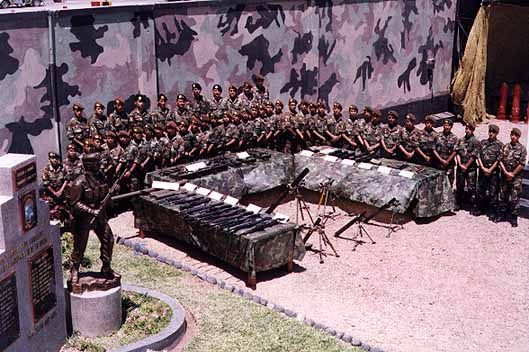 |
|
 TROPHIES CAPTURED THE ENEMY - TEST OF THE FIERCENESS OF THE SOLDIERS OF THE PERU ARMY AND UNDENIABLE MATERIAL TESTIMONY OF THE PERUVIAN VICTORY IN THE UPPER CENEPA TROPHIES CAPTURED THE ENEMY - TEST OF THE FIERCENESS OF THE SOLDIERS OF THE PERU ARMY AND UNDENIABLE MATERIAL TESTIMONY OF THE PERUVIAN VICTORY IN THE UPPER CENEPA
The victorious Soldiers of Commando Infantry pertaining to the Battalion of Commando Infantry "Commander Ladislao Espinar" Nº 19 of the Division of Special Forces of the glorious Army of Peru show proud their war trophies (mortars and guns) captured the invading enemy the 22 of February of 1995 (black Wednesday) in the Detachment of False Tiwinza (level 1061) that was the last redoubt of the defeated invading enemy in the zone, these trophies are the undeniable test that the defeated Ecuator army never recovered Tiwinza. Ecuador deceived crudely the MOMEP and the world. In false Tiwinza (Level 1061). Ecuador dishonourably lost the Conflict of the Cenepa!. |
The Cenepa conflict showed the equatorian government and military, that Peru will no longer tolerate any abuses or mutilations of the national territory.
In a possible confrontation with Peru the equatorians will always be the underdogs.
Equatorian soldiers were Cenepa's losers because they wore in their foreheads the shameful stigma of the cowardly men.
Equatorian have always lived a lie and as in other times were to falsify Cenepa events using their yellow press which covered equator's defeats with victory announcements.
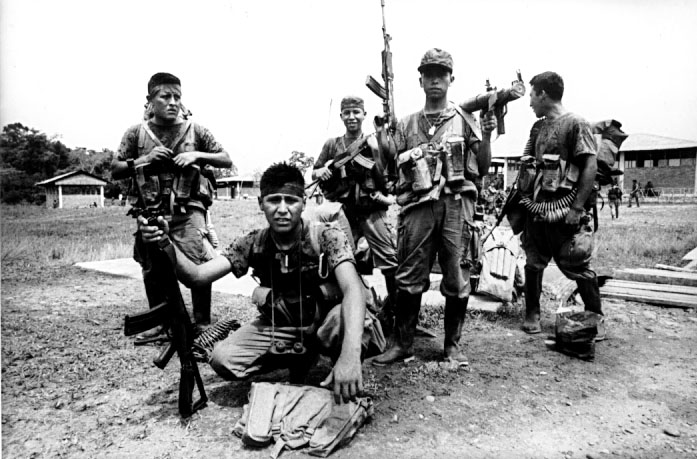 |
 SCHOOL OF COURAGE AND MASTERY IN THE BATTLE SCHOOL OF COURAGE AND MASTERY IN THE BATTLE
Peruvian fighters, masters of Cenepa -better known as the Giants of Cenepa ever since. They demonstrated to be warriors with lineage and holders of a School of courage and mastery in the battle, they were Lords of Cenepa battle field and due to them enemy was repulsed and repelled at all points.
The peruvian winners of Cenepa were elected Men of the 1995 year due to their bravery and victory over the invading enemy. To them the following homage words: "Brave and victorious Peru's troops!.... Each one of you is a saviour of your country! Peru hails you.... Your great feats and deeds will not fade or be forgotten.... Posterity will preserve them in their hearts. You saved your country with your blood!" .
General of Brigade of the Brazil Army Ariel Pereyra Da Fonseca, coordinator of the First Mission of Military observers Equator-Peru said about the peruvian soldiers the following words: "The peruvian soldiers are among the best fighters in all of the world", and in this manner his words recognized Peru's armed forces victory in the Upper Cenepa War.
Peruvian soldiers never die, they just fade away!. |
After complicated conversations Peru and Equator signed an peace agreement on October 26, 1998, This agreement includes demarcation of the border according to the Protocol of Peace, Friendship, and Boundaries of Rio de Janeiro, signed in 1942, the very hard peruvian juridical position was the winner and finally Equator accepted the Protocol of Peace, Friendship, and Boundaries of Rio de Janeiro, signed in 1942.
One of the most startling unique aspects of the agreement included the provision that a 247 acre hill (False Tiwintsa) the site of a Equatorian big defeat is to be "granted to Ecuador as private property, while still remaining part of Peru". As Equatorian President Mahuad noted in his speech, The solution proposed by the guarantors was extremely creative. They managed to divide juridical concepts that normally go together and that would seem to be indivisible. The concepts of sovereignty and property. They found they could be distinct. The proposal, which was a appeal made by Mahuad to Fujimori, is that False Tiwintsa remain under Peruvian sovereignty while belonging to Equator symbolically.
 |
 TUFIÑO'S MAP: A MAP SHOWING A FALSE EQUATOR TUFIÑO'S MAP: A MAP SHOWING A FALSE EQUATOR
Tufiño's Map: Equator's false map showing a make-believe border. In fact Equator was never the holder of those amazon territories which have always been peruvian lands since the independence times.
This extravagant map was never a reality and after peace agreement signed by Peru and Equator on October 26, 1998 Equator was forced to replace it by a map according to Protocol of Rio de Janeiro showing the real border. |
 Main
Main